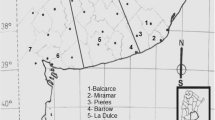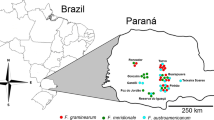Abstract
Data related to genetic diversity of F. graminearum chemotypes in Serbia are limited, thus the main objective of this study was to analyze the divergence of genes associated with the trichothecene cluster. F. graminearum was shown to be the dominant Fusarium species in Serbia occurring with frequency of 65.6% in 2016/2017 growing season. Isolates of F. graminearum dominantly belonged to SCAR type 1 (104/105) producing PCR product of 420 bp, but one isolate was proven to be SCAR type 6 producing PCR product of 400 bp. This is the first report of the presence of SCAR type 6 in Southeastern Europe. Results from this study reveal that F. graminearum populations were shown to be DON-DON chemotype with respect to Tri7 and Tri13 genes. All but one of these isolates were 15-AcDON chemotypes based on Tri3 gene. One isolate carried a deletion of Tri7 and was found to be 3-AcDON by using Tri303F/R primer pair. This is the first record on the presence of a 3-AcDON isolate with the Tri7 deletion in Serbia. The Tri7F/Tri7DON primer pair was not effective if isolates carried more than four 11-bp repeats in the Tri7 gene. Primer pair GzTri7f1/r1 was proven to be more effective in comparison with Tri7F/Tri7DON. Genetic variation ranged from 57 to 80% with no significant association of Tri7 alleles with localities. Results of this study have brought new insights into the distribution and population structure of F. graminearum in Serbia.






Similar content being viewed by others
References
Amarasinghe, C., Wang, J. H., Liao, Z. C., & Dilantha Fernando, W. G. (2011). Difference in TRI13 gene sequences between the 3-Acetyldeoxynivalenol producing Fusarium graminearum chemotypes from Canada and China. International Journal of Molecular Sciences, 12, 6164–6175.
Aoki, T., Ward, T. J., Kistler, H. C., & O’Donnell, K. (2012). Systematics, phylogeny and trichothecene mycotoxin potential of Fusarium head blight cereal pathogens. JSM Mycotoxins, 62, 91–102.
Bottalico, A., & Perrone, G. (2002). Toxigenic Fusarium species and mycotoxins associated with head blight in small-grain cereals in Europe. European Journal of Plant Pathology, 108, 611–624.
Carter, J. P., Rezanoor, H. N., Holden, D., Dejardins, A. E., Plattner, R. D., & Nicholson, P. (2002). Variation in pathogenicity associated with the genetic diversity of Fusarium graminearum. European Journal of Plant Pathology, 108, 537–583.
Chandler, E. A., Duncan, R. S., Thomsett, M. A., & Nicholson, P. (2003). Development of PCR assays to Tri7 and Tri13 and characterisation of chemotypes of Fusarium graminearum, Fusarium culmorum and Fusarium cerealis. Physiological and Molecular Plant Pathology, 62, 355–367.
Cornea, C. P., Israel-Roming, F., Ciuca, M., & Voaides, C. (2013). Natural occurrence of Fusarium species and corresponding chemotypes in wheat scab complex from Romania. Romanian Biotechnological Letters, 18(6), 2013.
de Kuppler, M. A. L., Steiner, U. M., Sulyok, M., Krska, R., & Oerke, E.-C. (2011). Genotyping and phenotyping of Fusarium graminearum isolates from Germany related to their mycotoxin biosynthesis. International Journal of Food Microbiology, 151, 78–86.
Demeke, T., Clear, R. M., Patrick, S. K., & Gaba, D. (2005). Species-specific PCR-based assays for the detection of Fusarium species and a comparison with the whole seed agar plate method and trichothecene analysis. International Journal of Food Microbiology, 103, 271–284.
Freeland, J. (2005). Molecular ecology. Chichester: John Wiley & Sons, Ltd.
Jennings, P., Coates, M. E., Walsh, K., Turner, J. A., & Nicholson, P. (2004). Determination of deoxynivalenol- and nivalenol-producing chemotypes of Fusarium graminearum isolated from wheat crops in England and Wales. Plant Pathology, 53, 643–652.
Kimura, M., Kaneko, I., Komiyama, M., Takatsuki, A., Koshino, H., Yoneyama, K., & Yamaguchi, I. (1998). Trichothecene 3-O-acetyltransferase protects both the producing organism and transformed yeast from related mycotoxins. Journal of Biological Chemistry, 273, 1654–1661.
Kimura, M., Tokai, T., O’Donnell, K., Ward, T. J., Fujimura, M., Hamamoto, H., Shibata, T., & Yamaguchi, I. (2003). The trichothecene biosynthesis cluster of Fusarium graminearum F15 contains a limited number of essential pathway genes and expressed non-essential genes. FEBS Letters, 539, 105–110.
Lee, T., Oh, D.-W., Kim, H.-S., Lee, J., Kim, Y.-H., Yun, S.-H., & Lee, Y.-W. (2001). Identification of deoxynivalenol- and nivalenolproducing chemotypes of Gibberella zeae by using PCR. Applied and Environmental Microbiology, 67, 2966–2972.
Lee, J., Chang, I-Y., Kim H., Yun, S-H., Leslie, J.F., Lee Y-W. (2009). Genetic Diversity and Fitness of Fusarium graminearum Populations from Rice in Korea. Applied and Environmental Microbiology, 75 (10), 3289–3295.
Leslie, J. F., & Summerell, B. A. (2006). The Fusarium laboratory manual. Ames: Blackwell Publishing.
Logrieco, A., Moretti, A., Ritieni, A., Bottalico, A., & Corda, P. (1995). Occurrence and toxigenicity of F. proliferatum from preharvest maize ear rot and associated mycotoxins in Italy. Plant Disease, 79, 727–723.
Möller, E. M., Bahnweg, G., Sandermann, H., & Geiger, H. H. (1992). A simple and efficient protocol for isolation of high molecular weight DNA from filamentous fungi, fruit bodies, and infected tissues. Nucleic Acids Research, 20, 6115–6116.
Nei, M. (1973). Analysis of gene diversity in subdivided populations. Proceedings of the National Academy of Sciences U S A, 70, 3321–3323.
Nicholson, P., Simpson, D. R., Weston, G., Rezanoor, H. N., Lees, A. I., Parry, D. W., & Joyce, D. (1998). Detection and quantification of Fusarium culmorum and Fusarium graminearum in cereals using PCR assays. Physiological and Molecular Plant Pathology, 53, 17–37.
Obradović, A., Stanković, S., Krnjaja, V., Nikolić, A., Ignjatović-Micić, D., Stepanović, J., & Duduk, B. (2017). Trichothecene chemotype diversitz of Fusarium graminearum isolated from wheat, maize and barley in Serbia. Genetika, 49(1), 355–364.
Pasquali, M., et al. (2016). A European database of Fusarium graminearum and F. culmorum trichothecene genotypes. Frontiers in Microbiololgy, 7, 406.
Schilling, A. G., Miedaner, T., & Geiger, H. H. (1997). Molecular variation and genetic structure in field populations of Fusarium species causing head blight in wheat. Proceedings of the fifth European Fusarium. Seminar, Szeged, Hungary. Cereal Research Communications, 25, 549–554.
Stanković, S., Tančić, S., Lević, J., & Krnjaja, V. (2008). Production of deoxinivalenol by Fusarium graminearum and Fusarium culmorum isolated from wheat kernels in Serbia. Cereal Research Communications, 26, 395–396.
Tok, F. M., & Arslan, M. (2016). Distribution and genetic chemotyping of Fusarium graminearum and Fusarium culmorum populations in wheat fields in the eastern Mediterranean region of Turkey. Biotechnology & Biotechnological Equipment, 30(2), 254–260.
Von der Ohe, C., et al. (2010). A comparison of aggressiveness and deoxynivalenol production between Canadian Fusarium graminearum isolates with 3- acetyl and 15-acetyldeoxynivalenol chemotypes in fieldgrown spring wheat. European Journal of Plant Pathology, 127, 407–417.
Waalwijk, C., Kastelein, P., deVries, I., Kerenyi, Z., van der Lee, T., & Hesselink, T. (2003). Major changes in Fusarium spp.in wheat in the Netherlands. Europen Journal of Plant Pathology, 109, 743–754.
Ward, T. J., Bielawski, J. P., Kistler, H. C., Sullivan, E., & O’Donnell, K. (2002). Ancestral polymorphism and adaptive evolution in the trichothecene mycotoxin gene cluster of phytopathogenic Fusarium. Proceedings of the National Academy of Sciences (PNAS), 99(14), 9278–9283.
Wegulo, S. N., Bockus, W. W., Hernandez Nopsa, J., De Wolf, E. D., Eskridge, K. M., Peiris, K. H. S., & Dowell, F. E. (2011). Effects of integrating cultivar resistance and fungicide application on Fusarium head blight and deoxynivalenol in winter wheat. Plant Disease, 95, 554–560.
Yli-Mattila, T. (2010). Ecology and evolution of toxigenic Fusarium species in cereals in northern Europe and Asia. Journal of Plant Pathology, 92(1), 7–18.
Yli-Mattila, T., & Gagkaeva, T. (2010). Molecular chemotyping of Fusarium graminearum, F. culmorum, and F. cerealis isolates from Finland and Russia. In Y. Gherbawy & K. Voigt (Eds.), Molecular identification of Fungi (pp. 159–177). Berlin Heidelberg: Springer.
Acknowledgements
This study was realized as a part of the TR 31066 project - Contemporary breeding of small grains for current and future needs, financed by the Ministry of Education, Science and Technological Development of the Republic of Serbia.
Funding
This study was realized as a part of the TR 31066 project - Contemporary breeding of small grains for current and future needs financed by the Ministry of Education, Science and Technological Development of Republic of Serbia.
Author information
Authors and Affiliations
Corresponding author
Ethics declarations
All authors are aware with the content of the manuscript and have agreed upon its submission to European Journal Plant Pathology.
Conflict of interest
The authors declare no conflict of interests. The manuscript has not been published in whole or in part elsewhere Eur J Plant Pathol. The manuscript is not currently being considered for publication in another journal. The manuscript is not split up into several parts to increase the quantity of submissions;
Ethical approval
This article does not contain any studies with human participants or animals performed by any of the authors.
Informed consent
Not applicable.
Electronic supplementary material
ESM 1
(DOCX 30 kb)
Rights and permissions
About this article
Cite this article
Župunski, V., Jevtić, R., Lalošević, M. et al. Diversity of trichothecene genotypes of Fusarium graminearum sensu stricto from winter wheat in Serbia. Eur J Plant Pathol 155, 461–473 (2019). https://doi.org/10.1007/s10658-019-01780-5
Accepted:
Published:
Issue Date:
DOI: https://doi.org/10.1007/s10658-019-01780-5




